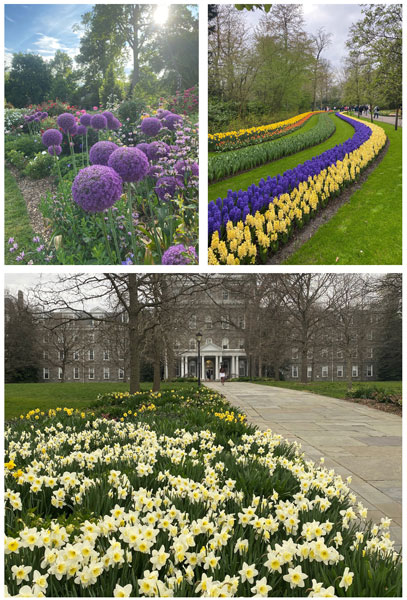3/1/2024
Don’t Feed the Wildlife
Andrew Bunting

Entire encyclopedias have been written on great bulbs for the home garden. The following is a nice cross section of tough, resilient bulbs that will multiply over time, forming larger masses and clumps, and in most cases, are squirrel and deer resistant—a problem which often plagues bulbs.
Pictured: Allium Globemaster showing off its flower power at Scott Arboretum. • A stunning display of hyacinth at the Keukenhof Garden in the Netherlands. • Daffodil Ice Follies
Let’s Talk Daffodils
The daffodils or narcissus are truly one of the harbingers of spring. February Gold can start to flower as early as February, depending on where you might live in the country, especially on the West Coast and in the Southeast. This daffodil in the cyclamineus group is characterized by both sulfur-yellow reflexed petals and a “cup” or “trumpet” of the same color. It reaches 10- to 12-in. tall. Jetfire has a similar stature, but the reflexed petals are golden-yellow and trumpet is an amazing contrasting deep orange. Jetfire is also slightly fragrant.
A great larger stature and naturalizing daffodil are the trumpet daffodils. Mount Hood is an heirloom daffodil introduced in 1921. It has large flowers with a pronounced trumpet that’s a pure alabaster white. King Alfred is all golden-colored counterpart. Other large stature daffodils include Ice Follies, with pure white outer petals and a soft yellow cup. Ceylon has an orange to scarlet cup that contrasts with the sulfur-yellow outer petals. Ice Follies is one of the most robust cultivars with large white flowers and a yellow central trumpet.
The small-cupped daffodils produce one flower per stem and the central cup is relatively small. Barret Browning is a great naturalizing daffodil with a small orange cup and contrasting pure white petals. There are many fantastic double-flowered daffodils, as well. Cheerfulness has fragrant flowers with blended double flowers of yellow and white.
The triandrus daffodils produce several pendant flowers per stem. One of the most elegant of all the daffodils is Thalia. Each stem has up to five pure white pendant flowers per stem.
All daffodils are completely deer and squirrel resistant. They can be used in both the garden and naturalized in meadows.
Turning to Snowdrop
The snowdrop, galanthus is a very small bulb that colonizes into large masses over time and can bloom from fall into late winter. In sunny parts of the garden, snowdrops might come into flower in January-February. Depending on the species and the cultivar, the flowers are characterized by pendant, alabaster white, teardrop-shaped flowers with intriguing green markings.
Galanthus nivalis is the most common. Only reaching a few inches tall, each flower is characterized by three pendant petals and a center cup with green markings. Over time, tight clumps will be formed, which will ultimately grow into large masses. Snowdrops can easily be divided and this should be done after the plants have finished flowering when they still have green leaves.
Galanthus Sam Arnott is one of the more robust cultivars. Galanthus elwesii, the giant snowdrop, will reach up to 10- to 12-in. tall. Galanthus elwesii Potter’s Prelude is one of the earliest snowdrops to bloom. It can start blooming in December and extend into early winter.
Fragrance & Style
Another wonderful small bulb to combine with the snowdrops and snowflakes are the grape hyacinths, muscari. Each 6-in. stem has a tight, spire-like cluster of small urn-like flowers. There are many species and cultivars of grape hyacinth. Muscari armeniacum Valerie Finnis has dense, fragrant, powder blue flowers. Siberian Tiger has pure white flowers and Muscaria aucheri Blue Magic has sky-blue flowers with a white eye. In the small garden they can be used in clumps, but for larger properties they can be used in large, naturalized masses.
There isn’t a spring bulb better for deer resistance in the garden than the ornamental onions, allium. Typically, they can be one of the latest flowering bulbs, coming into flower in May-June. Because of this flowering period, they can be great companion plants for geraniums, baptisias, etc. Many of the alliums are characterized by basal leaves and a long stem that’s accentuated with a bold and often large, round head of flowers. Purple Sensation has 4- to 5-in. wide heads atop 24- to 30-in. stems that are violet-purple in color. Globemaster has “flower power” unlike any other bulb, with 10-in. wide vivid purple clusters of flowers on tall 36-in. stems.
Other great flowering onions that have an abundance of stems with floriferous, robust flowers include Ambassador and Gladiator, and Mount Everest for white flowers. Allium christophii, the star of Persia, is a favorite and has large flowers that are a softer lavender-purple. Allium schubertii is diminutive in height, but has large, 12-in. globes of dark purple flowers that radiate from the stem and give an exploding, fireworks-like effect.
More diminutive in the garden is Allium moly with yellow flowers, Allium caeruleum for its sky-blue flowers and the drum-stick allium, Allium sphaerocephalon, which has wiry stems and is perfect for planting amongst perennials, where it can come up as perennials are blooming.
Unbeatable for fragrance in the garden are the flowering hyacinth, which come in blue, purple, white, pink and yellow. Stout, dense spikes of flowers sit atop the foliage and reach about 8- to 10-in. tall, making it a perfect bulb for the front of the garden. Hyacinthus Blue Jacket is a deep blue and Chicago is light blue. China Pink is soft pink and Woodstock is a deep purple.
These are all great bulbs that have proven to be both very ornamental and deer resistant in the garden. GP
Andrew Bunting is the Vice President of Horticulture for the Pennsylvania Horticultural Society (PHS), which uses horticulture to advance the health and well-being of the Greater Philadelphia region. To learn more about PHS, or to become a member and support greening initiatives in over 250 neighborhoods, visit PHSonline.org.